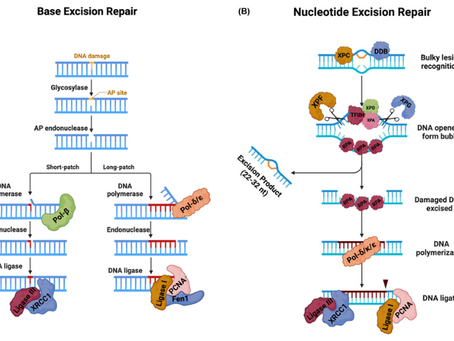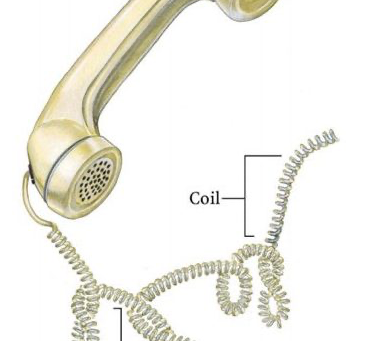top of page
Home: Blog2
Search


DNA Lesions IV
Homologous Recombination (HR) When replication fails catastrophically due to a lesion on the leading-strand template , the DNA being copied — the leading nascent strand — can break or become chewed back, leaving its 3′ end--the end that DNA polymerase epsilon needs to restart--located behind the polymerase, where it is inaccessible to the polymerase. If the fork simply tries to resume, it can’t: there is no usable 3' end starting point. At this point, the fork reverses, and
lscole
5 days ago4 min read


DNA Lesions III
In the last post, we talked about fork protection , a posture that replication forks take when a lesion stalls a polymerase. Fork protection unfolds in minutes to tens of minutes after the cell detects RPA-dsDNA. Recall that it stabilizes the replisome structure and protects exposed DNA, giving the cell time to deal with the lesion. But fork protection is only the first part of a two-part process called fork stabilization . Fork stabilization also includes fork reversal. How
lscole
6 days ago8 min read


DNA Lesions II
In the last post, I introduced the cell's two main DNA lesion repair pathways-- base excision repair (BER) and nucleotide excision repair (NER) . Both operate well beyond the replication fork during all of the phases of the cell cycle. But what happens if a lesion escapes BER and NER and finds itself in S phase in front of a moving replication fork? Most DNA lesions get past the CMG helicase but not the DNA polymerase, although some very large lesions can't get past the heli
lscole
Nov 308 min read


DNA Lesions I
In addition to DNA polymerase errors, the human genome--even in a perfectly healthy cell--is under constant assault from endogenous (internal to the cell) and exogenous (external to the cell, or environmental) chemicals and other agents that alter its chemistry, break its backbone, and distort its helical structure. In this post, we'll first consider what lesions are. We'll see that some are modest (e.g., a small chemical change to the base on a nucleotide) and some are mo
lscole
Oct 307 min read


Polymerase Errors II
As I mentioned in the last post, DNA polymerases sometimes insert a ribonucleotide (an RNA monomer) into a growing chain instead of a deoxyribonucleotide (a DNA monomer). When that happens, the bases do pair correctly. But the extra small chemical group that differentiates a deoxyribonucleotide from a ribonucleotides can still causes problems like strand breakage. DNA vs RNA . The sugar portion in a ribonucleotide is a ribose whereas in a deoxyribonucleotide it is a deoxyribo
lscole
Oct 304 min read


Polymerase Errors I
Life can't exist without the high fidelity transmission of genetic information from parent cell to daughter cell. DNA polymerases plays the central role in accomplishing this. DNA polymerases delta and epsilon only make an error (that is, attach a non-complementary nucleotide to a growing chain) once every 100,000 to 1 million nucleotide additions. But this is still too many. Those that arise must be fixed via a back-up system. In addition to polymerase errors, the human ge
lscole
Oct 308 min read


Winding Problems
As the CMG helicase moves along the double helix separating it into a leading and a lagging strand, it creates what is often referred to...
lscole
Oct 56 min read


Lagging Behind
DNA polymerases can only synthesize DNA in the 5' to 3' direction. That is an absolute rule that's determined by the biochemistry of nucleotide addition. Given the antiparallel nature of DNA, a corollary is that DNA polymerases can only synthesize off template DNA that is oppositely oriented in the 3' to 5' direction. Our leading strand exited the MCM2-7 ring of the CMG helicase 3' end first. So the DNA strand that will be synthesized using that strand as a template will be s
lscole
Sep 256 min read


Leading the Way
An important fact: The two DNA strands in a double helix are oriented in an antiparallel manner. That is, they run in opposite directions like the lanes of a two-lane highway. Recalling chapter ___, scientists describe the orientation of a given single strand of DNA as running either “3’-to-5’” (three prime to five prime) or “5’-to-3’” (five prime to three prime) based on the orientations of the deoxyribose sugars in the DNA backbone. But as a hard and fast rule, DNA polymera
lscole
Sep 126 min read


Diving Deeper
Let's take a closer look at two amazing molecular machines found in the replisome: the CMG helicase and the PCNA sliding clamp . Both...
lscole
Sep 118 min read


Assembling the Replisome
Our cell of interest is now in S phase and 30,000-50,000 replication origins along its genome have become licensed. The replication origins are licensed based on the presence of two MCM2-7 protein complexes (the licensing factors) lined up head-to-head forming a MCM double hexamer, or MCM-DH. Assembling a functioning replisome starting from an MCM-DH at a replication origin will involve the following four steps: (1) transformation of each of the MCM2-7s into a complete (but s
lscole
Sep 48 min read


Can I Please See Your License?
As we kick off the focus of this book—a deep dive into human genome replication—we’ll see that the process involves many different...
lscole
May 247 min read


Where Shall We Begin?
If someone had wanted a book in the 15th century it would have had to have been copied by hand from an existing one. The scribe would...
lscole
May 158 min read


Flexing Your Muscle Cells
In this post I present a perfect example of ATP-driven protein motor movement. ATP is a frequently employed driver of protein movement in...
lscole
May 135 min read


Eight Great Challenges of Genome Replication
Each time a cell divides, it creates a copy of both its genomes for the two daughter cells. It does so with extremely high accuracy (or "fidelity" in molecular biology parlance). Human cells copy their genomes with 99.99999999% accuracy. That equates to one single error per every 100 million nucleotides! Stop and think about that! In this post, we're going to review eight reasons why replicating the human genome is so challenging. Of course, the cell overcomes these challen
lscole
May 136 min read


ATP-Powered Proteins
A cell is a dynamic place. Enzymes are speeding up chemical reactions. DNA, RNA, and proteins are being synthesized. Molecular motors are...
lscole
May 73 min read


How DNA Is Stored
Two human genomes adding up to 6 billion base pairs are contained in the nucleus of every cell in your body. Different kinds of cells use...
lscole
May 27 min read


Watson's "Central Dogma"
We've covered proteins : polymers of amino acid monomers that fold up and perform most of the tasks in the cell. We've also covered DNA...
lscole
May 17 min read


What DNA Does
My last post covered the structure of DNA: what DNA is. In this post, I move on to function: what DNA does, or, maybe better, how DNA...
lscole
Apr 304 min read


What DNA Is
In this "Part I" post I'll be focusing on the structure of DNA--what DNA is . In the next, I'll cover how DNA functions--what it does ....
lscole
Apr 304 min read
Home: Contact
© 2025 by L. Scott Cole
Proudly created with Wix.com
bottom of page